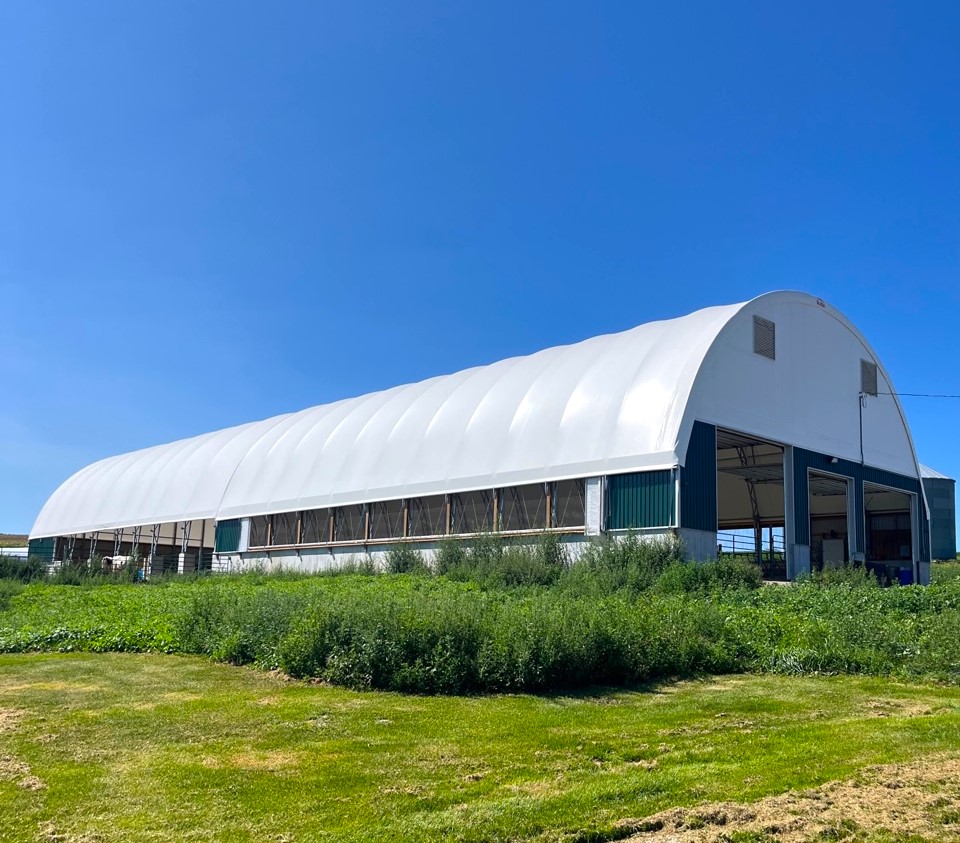Revolutionizing Sustainable Dairy Farming: The Fabric Barns’ Effect on Milk Production
by Admin | Dec 12, 2023

Did you know that cattle are the largest source of greenhouse gas emissions globally? As food systems are increasingly being understood as drivers of health and ecological impacts, new methods for food production are needed. Due to the anthropogenic greenhouse gas (GHG) emissions associated with the mass cultivation of ruminants – animals who digest their food with the help of microbes – the sustainability of these practices becomes challenging. In recent years, scientists have been investigating how and if sustainable dairy farming is possible, as milk consumption has many health benefits (bone health, blood pressure, source of vitamins and minerals). While many push for more sustainable farming practices, fabric structures are being recognized as a sustainable option for dairy barns and livestock farming, as they (1) increase dairy yields and (2) provide long-term, generational solutions.
An Overview of Why Cattle Emit GHG
Before we can understand how to reduce the GHG emissions associated with cattle, it’s imperative to know why and how they produce unwanted gases. According to the University of California, each year one cow will produce a whopping 220 pounds of methane. Methane is a greenhouse gas with a shorter atmospheric residency but a potency twenty-eight times stronger than carbon dioxide (the most well-known GHG). Cattle, along with sheep, goats, and deer, have microorganisms in their digestive tract (called methanogens) that produce methane as a byproduct of food breakdown. Therefore, while sustainability reforms in the agricultural sector are needed, it becomes challenging as cattle GHG emissions are endemic and unavoidable.
So, how can something as simple as a fabric barn create a more sustainable farm?
Increased Milk Yields and Productivity
While farmers can’t control market prices for milk-based commodities, they can control their dairy enterprise’s efficiency and sustainability. Did you know that our sustainable dairy barns increase milk yields? This is primarily due to the wealth of natural light that can penetrate the fabric, as it’s 16-19% translucent. As mentioned in Farming for a Better Climate, replacing fluorescent lights with LED lights – due to their increased similarity to natural daylight – can dramatically increase milk yields, and this is just with LEDs! As LEDs are nothing more than a synthetic mimic of natural light, imagine how much milk yields will increase when ample sunlight illuminates your dairy barn.
This wealth of sunlight also ensures your energy consumption will drastically reduce, with the National Renewable Energy laboratory estimating that fabric structures are 70% more energy efficient than traditional structures.
Inherently, if you need less cattle and energy to produce higher milk yields, your operation is more cost-effective and sustainable. This idea compliments one of the top ways to improve milk yield from the University of Minnesota. Cow comfort optimization is crucial for early lactation performance and peak yield. As such, our structures provide you with the room to reduce social stress and optimize your output while saving you money.
Thus, you can reduce your farm’s carbon footprint while saving money!
Sustainably Optimized Operational Efficiency
Beyond improving the efficiency of your livestock, our fabric buildings provide long-term eco-friendly solutions due to their durability, reduced waste, and minimal ecosystem disturbance.
Durability
Each custom-engineered fabric structure we produce undergoes a rigorous site evaluation to ensure the building can withstand extreme conditions (from large hail to strong winds). Further, every part of each structure’s steel frame is hot dip galvanized, providing generational use. As such, our facilities won’t need costly repairs or frequent replacements, cutting back on greenhouse gas emissions associated with construction and material shipping. Therefore, your carbon footprint shrinks on two fronts: (1) initial investment and (2) repairs.
Reduced Waste
Fabric buildings also work to reduce your carbon footprint both in the initial construction phase and in terms of repairs. As our buildings are composed of lightweight material compared to traditional facilities, fuel consumption during the shipping process becomes reduced. Further, since our structures don’t require nuts or bolts, on-site material waste is minimal; thereafter, when it’s time for a re-cover, the frame can be outfitted with a new fabric cover (while the old one is recycled!).
Minimal Ecosystem Disturbance
Lastly, our sustainable dairy barns are ecosystem friendly, as they reduce the need for extensive land excavation and foundation work, which ensures the biodiversity of organisms that live symbiotically around your barn will remain intact. Traditional buildings disrupt the environment’s natural biota through heavy machinery, laborious construction, and toxic chemicals, which harms your sustainability efforts.
Summary
At Calhoun, we’re proud that our structures are eco-friendly because we recognize that a holistic approach to sustainability is needed. Every effort counts.
For More Information
To get started on your sustainable dairy barn, click here.
To learn more about our livestock options, click here.
If you’d like to learn more about Calhoun’s sustainability and download our helpful infographic, click here.


